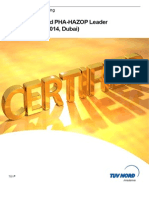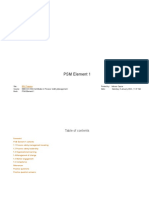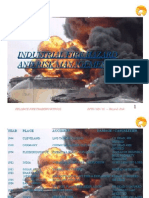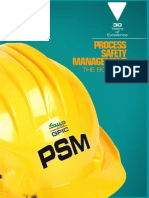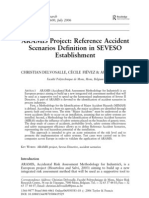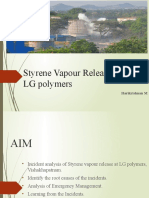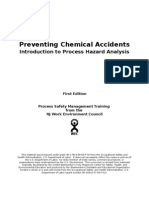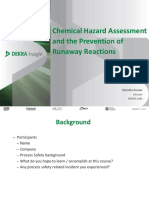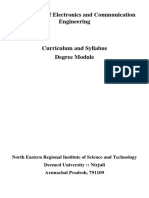Process Safety Notes 1
Uploaded by
Zia AhmadProcess Safety Notes 1
Uploaded by
Zia Ahmad1.
Process Safety - Terms & Definitions
Surya Bhusan- Process Safety Page 1
Process Safety Management: Application of management controls to operations involving
hazardous materials in a way that process hazards are identified, understood, and controlled so that
process-related injuries and incidences can be eliminated.
Process Hazards: A conditions that has the potential to result in a release of, or exposure to a
hazardous substances, which in turn can cause serious injury to personnel, significant propriety
damage, or significant environmental harm.
Hazards can usually be classified as one of the following generic potential events:
o Explosion Effects
o Thermal Exposure
o Acute Toxic Exposure
o Serious Injury from Special Mechanical Hazard
o Serious Injury form Special Electrical Hazard
Block Diagrams (BDs): It represents the simplest form of flow sheet which sets the basic concept of
the process. They show only what each step has to achieve but not how it is done.
Process Flow Diagrams (PFDs): PFD show all major equipment items with descriptions and
interconnecting flow lines for process materials. Design flow rates, temperatures, pressures and
stream compositions are also shown.
Piping &Instrument Diagram: P&IDs show all process pipes and valves (including drains and vents)
with numbers and sizes which refer to pipe and valve lists, all pressure relief valves and bursting
discs.
The objective of a P&ID is to indicate all service lines, instruments, controls and data necessary for
the design groups.
The PFD is the principal source of information for developing the P&ID.
Process Design Basis: It is the Description of the process including process chemistry, material and
energy balances, process steps , process parameters for each steps, limits for each parameters
(maximum, minimum, normal) and the consequences of deviations ( i.e., above maximum conditions
and below minimum conditions).
Equipment Design Basis: The assumption and logic upon which the design of the equipment is
based includes engineering data, engineering drawings, process and equipment sizing calculations,
equipment specifications, vendors blue prints etc.
High Hazard Processes (HHP): An HHP is any activity manufacturing, handling, storing or using
hazardous substances that, when released or ignited can result in deaths or irreversible human
health effects, significant property or environment damage or off-site impacts due to acute toxicity,
flammability, exclusivity, corrosivity, thermal instability, latent heat or compression. Local regulations
like Control of Major Accidental Haz. Rule 1990, MSIHC Rule 1989.
Consequences: Potential effect of the hazards on people, property, environment, community,
business and companys reputation.
Process: Any activity conducted by an employer as part of manufacturing / processing steps that
involves hazardous material, including any use, storage , manufacturing or handling of these
materials.
Surya Bhusan- Process Safety Page 2
Process incident is an event that directly involves or could involve process equipment and materials,
including on-site storage and handling of process materials. Incidents involving the uncontrolled
release of hazardous substances or involving the uncontrolled release of the energy of hazardous
substances.
Equipment critical to Process safety: These are those equipments whose failure could result in
exposure to hazardous substances, which in turn could result in death or serious injury ( P) or which
could result in significant property/asset damage (A) or significant environment harm(E) or company
reputation (R).
These are those equipments for which there is a system of safeguard as indicated in the column of
what if check list. Every process taken for PSM should have a list of all PSM critical equipments.
Interlocks: A safety device normally automatically activated by a sensor to prevent hazardous
conditions in a process from occurring. Also called a trip or automatic shutdown in some situations.
Severity of Consequences: For a particular hazard scenario, the degree to which personnel,
property, or the environment may be adversely affected. There are usually two severity columns in a
worksheet: one that refers to the expected severity of an items (such as a consequences) and usually
represents the worst case scenario, and one that refers to the expected severity of an item after the
recommendations have been implemented
Likelihood (L): The probability or frequency of occurrences of a hazard scenario, based on the
agreed upon definitions for the study. There are usually two L columns in a worksheet: one that
refers to the expected likelihood of an items and one for the likelihood of the item after the
recommendations have been implemented.
Process Hazards Analysis: An organized program to identify, evaluate and control hazards
associated with manufacturing, storage and transportation activities. It is a systematic and
comprehensive study of a process using recognized methods of hazards identification. It is comprised
of a consequences analysis and a process hazards review.
Process Hazard Review: `A searching and organized examination of specific parts of a processes or
systems. Demonstrated methodologies are used to identify hazards, conclusions and
recommendations are the developed.
Reliability Engineering: Process of evaluating how long a system and its individual components
can be operated safely before they must be taken out of service for maintenance or replacement.
Safeguards: Protective features or measures to guard against or prevent hazardous conditions from
arising or to mitigate their consequences. For example, pressure relief, process safety interlocks,
preventive maintenance and emergency response plans are safe guards.
Personnel safety incidents (e.g., slips; trips; falls; being hit, struck, or crushed by non-process
equipment; and hand lacerations involving any employees associated with either non process
equipment or process equipment that is not operating/in use) are not considered process incidents.
Emergency Response Planning Guideline: A listing of concentrations of hazardous substances in
air that can impact the health of people exposed. The three classification levels are,
Surya Bhusan- Process Safety Page 3
o ERRPG1: Maximum airborne concentrations that will generate only mild transient health
effects for up to a one hours exposure.
o ERRPG2: Maximum airborne concentrations that will not produce irreversible or other serious
health effects for up to a one hours exposure.
o ERRPG3: Maximum airborne concentrations below which life threatening health effects will
not be experienced for up to a one hours exposure.
Surya Bhusan- Process Safety Page 4
2. Process Safety Information (PSI)
Surya Bhusan- Process Safety Page 5
Process Safety Information (PSI) documentation consists of the three elements listed below.
A) Process Design Basis
Process Design Basis documentation includes items such as those listed below and updated based on
input from management of change systems.
Process block and flow diagram that will include water, air, electrical, centralized lubrication if any,
pneumatic/hydraulics system flow diagram besides main process flow diagram.
Description of the process steps, process parameters for each step, limits for each parameter
(maximum, minimum, or preferred conditions for parameters such as temperature, pressure, flow and
composition) and the consequences of deviation outside the limits at each steps of the process.
Maximum intended inventory of hazardous substances.
Clear description of process chemistry with discussion of potential for undesirable side and/or
runaway reactions
B) Hazards of Materials
Hazards of Materials documentation includes the physical and chemical properties of process substances
pertaining to their toxicity, flammability, explosiveness, corrosiveness, reactivity, permissible exposure
limits, thermal/chemical stability and other characteristics that, when released, create hazards to people,
facilities and the environment.
C) Equipment Design Basis
Safety, health and environmental related-Equipment Design Basis documentation includes the
assumptions and logic (not only the whats, but also the whys) on which the design of the equipment
is based. Documentation of pressure relief systems, protective safety (interlock) systems, emergency
alarm systems, electrical classification, process ventilation systems and fire protection systems is
required for both higher hazard processes and lower-hazard operations.
Surya Bhusan- Process Safety Page 6
PSI activities should be identified with time frame for each process depending on the prioritization. For
collection above information or for completion of PSI in systematic manner we need to do following
activities:-
Plan for collecting PSI for implementation of Baseline PSRM Form No.: PSRM/PSI_PLAN/0.1 Rev. No.:00 Eff.dt.:01.01.09
Department : Process :
Month1 Month2 Month3 Month4
Activity
Wk 1 Wk 2 Wk 3 Wk 4 Wk 1 Wk 2 Wk 3 Wk 4 Wk 1 Wk 2 Wk 3 Wk 4 Wk 1 Wk 2 Wk 3 Wk 4
1 Identify and list processes and sub processes.
Assign responsibility for each process and sub process
2
(Leader & team members)
3 Collect / prepare BDs & PFDs
Describe the process steps with process parameters for
4 each step, their limits (max., min. & desired values) and
process capabilities to manage deviations.
List the inventory of chemicals & hazardous material and
5
collect MSDS for all.
List the equipment critical to process, safety and
6
environment.
7 Collect / prepare PIDs
Collect / prepare detail of each equipment e.g. ordering
8 information, operation & maintenance manual, schedule
for maintenance, inspection and testing.
9 Develop the PSI library along with document control
system.
10 Implement & maintain document control system for PSI
1. Process selection criteria (Form No.:PSRM/PSI/PSC/001)
Identify and list processes and sub processes for conducting PSI and categorize them on the basis of
criteria given below:-.
Criteria for selection of Proces for PSRM F o rm N o .P SR M / P SI/ P SC / 001 R ev.N o .:00 Eff. D t.:01.01.09
Department : Document No. : Rev.No.: Eff.Dt.: Date:
Criteria#1 Criteria#2 Criteria#3 Criteria#4 Criteria#5 Criteria#6 Baseline Total
Objective of the job Section
Acute Explosivity Flamability Corrosivity Thermal Latent Heat PSRM PSRM
of the
Toxicity Instability or
department/section
Area Process Compression
Surya Bhusan- Process Safety Page 7
Baseline PSRM=Process Safety Information (PSI) Collection for selected sections and Total PSRM
means All technological elements of Process Safety & Risk Management (PSRM) will be done in
selected sections - [section name here] If
A. If a process/sub process has potential to result in uncontrolled release of energy in the form of ,
Acute toxicity or/and Explosiveness or/and Flammability would qualify for Total PSRM
B. If the process/sub processes has potential for corrosivity and/or thermal instability and /or Latent
heat would qualify for base line PSRM i.e. only PSI to be collected
C. Even if the process /sub-process qualify in the category (B) may result into high consequences
(multiple fatality, huge assets loss, damage to brand image & result into environmental pollution)
would qualify for total PSRM. This requires approval of Chief S&E.}
Definitions of PSRM Criteria elements
a) Thermal Instability means under certain temperature & condition material changes own
chemical & physical properties i.e. unstable with increase/decrease in temperature
Example
LPG gas stored in Cylinder- it may explode due to exceeding the design limit with rise in temp.
Steam pipe line explosion due to water condensation (If Temp. decreases steam will convert in
to water)
b) Toxicity is the degree to which a substance can damage an organism.
Acute toxicity looks at lethal effects following oral, dermal or inhalation exposure. I.e. such
exposures where substances may cause lethality to the entire body, lethality to specific organs,
major/minor damage
Example:
Release of CO Gas, Ammonia Gas in such amount that people may die (Equivalent to LC 50, LD 50
values)
c) Flammability: Use, Handling, storage or transportation of flammable liquid or gas having
quantity equal to or more than 4535.9 kg (as per Standards) except for
Hydrocarbon fuels used solely for workplace consumption as a fuel (e.g propane used for comfort
heating, gasoline for vehicle refueling), if such fuels are not a part of a process containing another
highly hazardous chemical covered by this standard:
Flammable liquids stored in atmospheric tanks or transferred which are kept below their normal
boiling point without benefit of shilling or refrigeration.
But as decided in APSSC if department feel that they are Use, Handling, storage or transporting
even less quantity but its consequence is high they can select it for complete PSRM
d) Corrosive: A corrosive substance is one that will destroy or irreversibly damage another surface
or substance with which it comes into contact.
Example:
Alkali (NaOH) / Acid (H2SO4, HNO3 and HCl) passing through metal pipeline, will corrode the pipe
line after some time & pipe, valves, Pump may fail
e) Explosion: An explosion creates a shock wave & is a rapid increase in volume and release of
energy in an extreme manner, usually with the generation of high temperatures.
Example:
Mechanical Explosion / BLEVE - bursting of a sealed or partially-sealed container under internal
pressure- Propane Tank, Water & Hot metal etc.
Chemical explosives Explosives, Oxidation reaction i.e. explosion in furnaces (H2 & O2 mixing)
etc.
Surya Bhusan- Process Safety Page 8
f) Latent heat is the heat released or absorbed by a chemical substance or a thermodynamic
system during a change of state that occurs without a change in temperature, meaning a phase
transition
Example
The quantity of heat absorbed or released by a substance undergoing a change of state, such as
ice changing to water or water to steam, at constant temperature and pressure
2. PSI team formation (Form No. PSRM/PSI/TEAM/015)
Assign responsibility for each process and sub process (Leader & team members).The PSRM team
should be a Cross functional team/ Multidisciplinary team including experts and experienced personals
from both operations & maintenance.
3. BDs and PFDs collection
Collect / prepare BDs & PFDs that will include water, air, electrical, centralized lubrication if any,
pneumatic/hydraulics system flow diagram besides main process flow diagram.
I. Block Diagram includes
Functional steps of the process in the block
Main input material & utilities in the process.
Main output & by-product of the process.
All critical equipments (as identified in step6.) must be highlighted in BDs/PFDs.
Information on all waste streams leaving a process for on or off-site disposal must be
mentioned. If not clearly shown clearly on flow-sheets and material balances sheet, source
and composition should be detailed for each waste.
II. Process Flow diagram includes
critical equipments designed for safety of the process
all critical process parameters designed for safety of the process
Major equipment symbols, names and identification numbers critical to the Process Safety &
Environment.
Control valves and valves that affect operation of the system, the deviation may lead to very
high consequences resulting in injury/fatality of Human, damage to environment, Asset loss &
damage to Brand Image.
System ratings and operational values as minimum, normal and maximum flow, temperature
and pressure
4. Process Design Basis (PSRM/PSI/PDB/002)
Process design basis for Safe operation of the Process Form No: PSRM/PSI/PDB/002 Rev.:00 Eff.Dt.: 01.01.'09
Dept: Doc.No.:
Process/ Sub Process: Rev. No.: Eff.Dt.:
Control/Measures to
Safe Operating Limit Safe Working Limit Consequence of deviation (SOL) avoid deviation (Existing
Sl No. Parameter Safegaurd)
Min Max Min Max Min. Max. min max
Surya Bhusan- Process Safety Page 9
This section provides useful information in detailing the process history as in how did the current process
following the initial design and start-up. It is followed by the description of the current process being used
which includes description of the process steps, process parameters for each step, limits for each
parameter (maximum, minimum, or preferred conditions for parameters such as temperature, pressure,
flow and composition) and the consequences of deviation outside the limits at each step of the process.
Control strategy, including the effect of control variables and strategy around hoice of control limits may
be outlined.
Inclusion of ingredient charges and critical ratios is appropriate. Chemical interactions with water, air or
other chemicals as per the process reactants, intermediate or byproduct, and a chemical interaction
matrix (Form No.: PSRM/PHA_CIM/006) for materials, which could probably be mixed (including those
intended for other on-site processes)must be documented. Clear description of process chemistry with
discussion of potential for undesirable side and/or runaway reactions is specified.
Also an Experimental Operating Instruction (EOI)/Test Authorization (TA) listing, or a reference to its
location must be provided.
5. Hazards of materials (PSRM/PSI/HOM/003)
HAZARD OF THE MATERIAL F o rm N o : P SR M / P SI/ H OM / 003 R ev.:00 Eff.D t.: 01.01.'09
Dept: Doc. No.:
Process/ Sub Process: Rev. No.: Eff.Dt.:
Hazardous
Sl. No. Reactivity Toxicity Flammability Explosiveness Exposure TLV/STEL/LD50
Material
Hazards of Materials documentation includes the physical and chemical properties of process
substances pertaining to their toxicity, flammability, explosiveness, corrosiveness, reactivity, permissible
exposure limits, thermal/chemical stability (collected from msds supplied by supplier) and other
characteristics that, when released, can be hazardous to people, facilities and the environment.
Maximum intended inventories of hazardous substances are documented so that hazardous situations
are not inadvertently created; for example:
The deluge system may be designed based on an upper limit in storage quantity, or
An upper inventory limit in a vessel / tank/ gas holder is necessary to ensure room is available for
adding gases/liquids. Also this information serves as a back-up document for PHA.
6. List of equipment critical to process safety and environment
Basis for identification of critical equipments (Ex.: drawing reference from incidences database,
failure report, etc.)
Identification of all critical equipments designed for safety of the process to be listed drawing
reference from the Process Flow diagram in step#3 of PSI plan
This section also include summary of the permit/licences history, and key compliance considerations
(such as what triggers a permit amendment or sampling requirements)
Surya Bhusan- Process Safety Page 10
7. Collect / prepare PIDs
Piping & instrumentation diagram:
No. of P&IDs available for that process must be listed
If more than 4 P&IDs are available check whether process has been segregated in to sub-process
Check whether relevant Electrical line diagrams, circuit diagrams, mechanical drawing for the
process/sub-process are available
Check whether all the P&IDs of that process/ sub-process are kept in one place
Also it has to be ensured that document nos. are specified for all P&IDs along with their relevant
electrical line diagrams, circuit diagrams
8. Equipment Design Basis (Form No: PSRM/PSI/ESDB/004)
Details of Equipment design Basis Data Sheet F o rm N o : P SR M / P SI/ ED B / 004 R ev.:00 Eff.D t.: 01.01.'09
Dept: Doc. No.:
Process/ Sub Process: Rev. No.: Eff.Dt.:
Description Schedule for Associated Alarms /
Controlling Operating/maint.
Sl.No. of the Make/Model Maint./Calibration/ Interlocks/logics/loop
Parameter manual details
Equipment inspection Diagrams
Documentation for process equipment (vessels, heat exchangers, etc.) includes,
Description of the equipment which will include equipment specifications, design condition along with
the codes & standards applied to it, materials of construction, sizing calculations and specification
drawings.
Controlling Parameters of the equipment
Make and Model
Vendor blueprints and instruction manual.
Schedule for Maint./Calibration/inspection
Safety system such as interlocks and detection & suppression systems. (a reference to OP can also
be given instead)
The logic used to establish alarms/interlocks, how to respond to them and the consequences of
deviations is also mentioned.
The basis for SOC and SOL limits will be documented. The documentation will provide thorough
explanation of the key concerns around each specific operating limit.
9. Develop the PSI library along with document control system at Centralized location
For PSRM team members to discuss their process related study \
To keep their P&ID, Mech. Drawings, Electrical line diagrams, etc.
10. Implement & maintain document control system for PSI
Document No. in line with EHSMSM/QMS
Surya Bhusan- Process Safety Page 11
3. Process Hazard Review (PHA)
Surya Bhusan- Process Safety Page 12
A PHA is an in-depth review of a process by a team composed of members who have the required expertise
and experience to identify potential hazards of a process or hazards that may result from abnormal
operation, equipment failure, or human error. Process Hazard Analyses (PHAs), also called process hazard
evaluations, use various methods to identify, evaluate and control the hazards involved in a process.
The PHA team must have an up-to-date Process Information Package before the PHA has begun. The
package includes:
Surya Bhusan- Process Safety Page 13
PHA activities should be identified with time frame for each process depending on the prioritization. For
collection above information or for completion of PHA in systematic manner we need to do following
activities:-
1. Hazards Identification (Form No.: PSRM/PHA_HI/005)
Hazards are classified into the following three categories:
Chemical hazards
Process potential energy sources
Special Mechanical, Electrical hazards and /or other specific hazards related to steel manufacturing
process.
The following sources, means, and methods shall be used to assist in identifying the above three
categories of the hazards:
Process safety information (PSI)
Serious process incident reports
Previous PHAs
Management of Change documents
Material Safety Data Sheet (MSDS)
Chemical Interaction Matrix
Process experts
Field tour
Surya Bhusan- Process Safety Page 14
2. Chemical Interaction Matrix (Form No.: PSRM/PHA_CIM/006)
A chemical and material incompatibility matrix or equivalent, typically referred to as a chemical interaction
matrix, shall be developed to identify hazardous effects that could foresee ably occur from the inadvertent
mixing of different materials. The matrix should consist of qualitative to semi quantitative information
about the chemical reactivity hazards from intentional and unintentional chemical reactions.
Form No.: PSRM/PHA_CIM/006 Rev.No.:00 Eff. Dt.:01.08.'09
` Chemical/Mtrl. Of Chemical/ Mtrl of Chemical/Mtrl. Of Chemical/Mtrl. Of Chemical/ Mtrl of Chemical/Mtrl. Of Chemical/Mtrl. Of Chemical/ Mtrl of
construction A1 construction A2 construction A3 construction A4 construction A5 construction A6 construction A7 construction A8
Chemical/Mtrl. Of
construction A1
Chemical/ Mtrl of
construction A2
Chemical/Mtrl. Of
construction A3
Example
Name of LD gas Water Nitrogen Oxygen Air Hot metal Slag Fluxes
Chemical
LD gas No No No Yes Yes No No No
Water No No No Yes Yes Yes
Nitrogen No No No No No No
Oxygen No No Yes Yes Yes
Air NO No No No
Hot metal No Yes Yes
3. Field Tour (Form# PSRM/PHA_FT/007) :
In a Process Hazard Review (PHR), it is important that PHA team visits the site and verifies the existing
facilities with respect to the P&IDs and facility sitings checklist. The team shall be guided by a hands
on experience person and shall list out all their findings with respect to present conditions temporary
structures, make-shift arrangements, existing physical barriers, temporary work being carried out at
sites, health of equipments / structures / piping at the site pathways, additional piping, equipments or
any other changes carried out and has not been mentioned in the process flow sheet / P&IDs. The team
shall also develop list of hazards during the tour and discuss at site with the operating people. After
conducting field tour, team shall compile the findings and take the findings into consideration while
conducting PHR. The tour gives the team a clear picture of the process and the lay out
4. Consequence Analysis (Form No.: PSRM/PHA_CA/008):
Consequence analysis is an essential element in all process hazards analyses. It is the estimation of
potential harmful effects resulting from episodic process accidents that usually involve a fire, explosion, or
release of toxic material. It should
List types of process events possible such as fire, explosion, or toxic release (both worst case and
most probable case)
Estimate potential release quantities
Estimate distance to different levels of concern, such as toxic concentrations, thermal effects,
overpressure, or significant environmental effects
Estimate safety and health effects on the site and community for potential effects.
Surya Bhusan- Process Safety Page 15
Following software is available for the QRA
o US EPA RMP Lookup Tables
o DNV Phast or Safer Trace
o ALOHA
Form No.: PSRM/PHA_CA/008 Rev.No.00 Eff.Dt.:01.08.'09
CONSEQUENCE ANALYSIS
AREA :
PROCESS NAME :
LIST OF PROBABLE EVENTS WHICH CAN LEAD TO MOST HAZARDOUS EVENTS (FIRE,EXPLOSION,
RADIATION, TOXIC RELEASE, MECHANICAL RISKS, ELECTRICAL RISKS, ENVIRONMENTAL)
HIGH CONSEQUENCE HAZARDS FROM THE ABOVE :
SL.NO. HAZARDOUS RELEASE QTY RELEASE ESTIMATED IMPACT ON
EVENT DURATION EXPOSURE PEOPLE,
RANGE FACILITIES &
ENVIRONMENT
1
2
3
5. Process Hazards Review (PHR)
The PHR is a systematic and comprehensive study of the hazardous events that could occur in the
process. Select a hazard evaluation method; one of the following methods of analysis is applied to the
process segments being studied:
Steps in a Process Hazards Review
Select one of four methodologies for the review.
Identify hazardous events that could occur in the process and evaluate RISK using COMPANY
SPECIFIC RISK MATRIX
List the present safeguards to prevent the hazardous occurrence.
Evaluate whether the present safeguards are adequate.
Recommend additional safeguards if the existing safeguards are judged to be inadequate.
Summarize recommendations and all review findings in a report and present it to management.
Surya Bhusan- Process Safety Page 16
6. Facility Siting (Form No.: PSRM/PHA/FS/010):
Facility sitting means identifying how hazardous events in a process block can affect plant personnel in
and around the hazard epicenter. Facility review is the evaluation of the protection people has in site
buildings against potential hazardous events in the process.
a. What is the impact of the process incidents on the building?
b. Will people in the building be impacted?
c. Is relocation or reinforcement possible?
The above can be analyzed by using the following set of questionnaire as listed
Worst case scenario and the assumptions if most probable scenario is used.
Fire, explosion, and toxicity implications of the hazard being realized.
Facilities within the affected zone of the realized hazards .
Existence of the emergency response systems and facilities to handle the realized hazards.
Impact of the realized on the facilities identified above.
Occupancy of the facilities generally every manned area will have at least 2 persons per shift hence
Avg. Occupancy Rate shall be taken as 24*2*168= 336 per week.
No. of occupants and the impact on the occupants if the hazard is realized.
If the impact is fatality and/or significant environment damage, and/or huge financial loss, develop
recommendations
7. Human Factor (Form No.:PSRM/PHA/HF/011):
Human Factor includes all aspects of human interaction with the work environment. Human error-likely
situation may involve one or more of the following:
Deficient procedures or procedural violations
Inadequate, inoperative, or misleading instrumentation
Poor layout or design of controls
Poor task design
Poor communication
Conflicting priorities
8. Inherently Safer Process (Form No.:PSRM/PHA/ISP/012):
In a Process Hazard Review (PHR), consideration should be given to how to make the process
inherently safer by eliminating or minimizing hazards. The What If/Checklist method is the best format for
this type of consideration, since FMEA and HAZOP methods assume the process is safe if operated as
designed. Factors to be considered are as follows:
Intensification: Minimize intensification by using small quantities of hazardous materials
Substitution: Eliminate hazard by replacing hazardous material
Attenuation: Moderate, or attenuate, by using less hazardous conditions
Limitation: Limit impact by designing facilities (Vessel) to contain overpressure or other hazardous
conditions
Simplification: Simplify process so that operating errors are less likely and/or process is free of errors
Surya Bhusan- Process Safety Page 17
9. Management Review (Form No.: PSRM/PHA/MR/013):
Form No.: PSRM/PHA/MR/0013/ Rev.No.:00 Eff. Dt.:01.08.'09
Source( PHR Target
S.No Hazard Risk Score Recommendation Priorty Remarks
Form/Page No) Date
The purpose of Management Review is to recognize the work done by PHA team, understand reason for
recommendations, and ensure that all recommendations are adequately addressed with detail plan with
name-wise responsibility and that basic purpose of PSRM implementation is met.
It also communicates ownership of implementation lies with Management of the department and not on
the team conducting PHAs.
The team headed by Chief of department with all Heads of different section shall review
recommendations and will have authority to accept, or modify or reject the recommendation based on the
logic and reasons explained by PHA team. The PHA team will present the recommendations in the
following formats,
The management must assign follow up responsibility and dates for completion of each recommendation.
If the recommendation is rejected, the reasons must be documented and appended to the PHA report.
During the PHA, unsafe conditions or practices may be discovered, which could have potential for injury,
but not for causing a major hazardous event. These improvement opportunities should not be ignored,
and they should be reported to the designated manager in a separate letter. However, this information on
improvement opportunities should not appear in the PHA report.
Surya Bhusan- Process Safety Page 18
You might also like
- Guidelines for Defining Process Safety Competency RequirementsFrom EverandGuidelines for Defining Process Safety Competency Requirements3/5 (1)
- Latinos and The Nation's Future Edited by Henry G. Cisneros and John Rosales100% (2)Latinos and The Nation's Future Edited by Henry G. Cisneros and John Rosales273 pages
- Milestone 2 - HAZOP & HAZAN (Final Completed PDFNo ratings yetMilestone 2 - HAZOP & HAZAN (Final Completed PDF76 pages
- Fundamental of Process Safety Management System (PSM)100% (1)Fundamental of Process Safety Management System (PSM)41 pages
- Relative Ranking Techniques: Safety ReviewsNo ratings yetRelative Ranking Techniques: Safety Reviews16 pages
- Week 11 Fires and Explosions in Chemical and Petrochemical Industries100% (1)Week 11 Fires and Explosions in Chemical and Petrochemical Industries37 pages
- Jepg ... SJEC - Jan 2023 Module On PROCESS SAFETYNo ratings yetJepg ... SJEC - Jan 2023 Module On PROCESS SAFETY20 pages
- Industrial Fire Hazard and Risk ManagementNo ratings yetIndustrial Fire Hazard and Risk Management18 pages
- A Grid Based Approach For Fire and Explosion Consequence Analysis100% (1)A Grid Based Approach For Fire and Explosion Consequence Analysis13 pages
- Behavioural Safety and Major Accident Hazards Magic Bullet or Shot in The DarkNo ratings yetBehavioural Safety and Major Accident Hazards Magic Bullet or Shot in The Dark8 pages
- Efficient PHA of Non-Continuous Operating ModesNo ratings yetEfficient PHA of Non-Continuous Operating Modes25 pages
- Use Maximum-Credible Accident Scenarios For Realistic and Reliable Risk Assessment100% (1)Use Maximum-Credible Accident Scenarios For Realistic and Reliable Risk Assessment9 pages
- Introduction To Process Safety Identification of Hazards and Critical ControlsNo ratings yetIntroduction To Process Safety Identification of Hazards and Critical Controls25 pages
- Interpretation of IP15 in Process Plant Design: A Commonsense ApproachNo ratings yetInterpretation of IP15 in Process Plant Design: A Commonsense Approach8 pages
- General Principles For Hazrdous Area ClassificationNo ratings yetGeneral Principles For Hazrdous Area Classification13 pages
- Fire & Explosion Risk Assessment (Kuliah Tamu Unair - 09 Juni 2012) BaruNo ratings yetFire & Explosion Risk Assessment (Kuliah Tamu Unair - 09 Juni 2012) Baru50 pages
- WWW - Hse.gov - Uk Comah Buncefield Bstgfinalreport PDFNo ratings yetWWW - Hse.gov - Uk Comah Buncefield Bstgfinalreport PDF118 pages
- Overview of Bowtie Methodology of Risk Analysis and Its ApplicationNo ratings yetOverview of Bowtie Methodology of Risk Analysis and Its Application6 pages
- ARAMIS Project - Event Prediction (General)No ratings yetARAMIS Project - Event Prediction (General)19 pages
- 5 Day Course Outline of Process Safety Related TopicsNo ratings yet5 Day Course Outline of Process Safety Related Topics3 pages
- Chemical Process Safety: Kathmandu UniversityNo ratings yetChemical Process Safety: Kathmandu University48 pages
- Styrene Vapour Release Incident at LG Polymers: Harikrishnan MNo ratings yetStyrene Vapour Release Incident at LG Polymers: Harikrishnan M32 pages
- Safety Management and Applications in Process Industries: Workplace HazardsNo ratings yetSafety Management and Applications in Process Industries: Workplace Hazards45 pages
- Hazid Report Form: Project: Drawing Nos Date: Sheet No: Area or System: AttendeesNo ratings yetHazid Report Form: Project: Drawing Nos Date: Sheet No: Area or System: Attendees12 pages
- Process Safety Management: Kharil Ashidi B. Abdul Jabar Q-SHE-S Dept Nippon Steel Engineering Co., LTD100% (1)Process Safety Management: Kharil Ashidi B. Abdul Jabar Q-SHE-S Dept Nippon Steel Engineering Co., LTD37 pages
- Why Process Safety Management Audits FailNo ratings yetWhy Process Safety Management Audits Fail6 pages
- Process Safety Management CH-523 Prof.: Zahoor@neduet - Edu.pkNo ratings yetProcess Safety Management CH-523 Prof.: Zahoor@neduet - Edu.pk70 pages
- Explosion Risk Analysis ERA' For FLNG Facilities: The Main ChallengesNo ratings yetExplosion Risk Analysis ERA' For FLNG Facilities: The Main Challenges6 pages
- Upsc ae industrial safety and standardsNo ratings yetUpsc ae industrial safety and standards56 pages
- Chapter 22 Prevention of Oppression and MismanagementNo ratings yetChapter 22 Prevention of Oppression and Mismanagement14 pages
- THE Is The: Mobile Newsfeed Big OpportunityNo ratings yetTHE Is The: Mobile Newsfeed Big Opportunity18 pages
- Sap Iot Connected Manufacturing Mill Products PDFNo ratings yetSap Iot Connected Manufacturing Mill Products PDF18 pages
- Infosys Ltd. Vs Computer Software: Assets Summary (Industry Benchmark) : Annualised: Mar 2015 - Mar 2017: Rs. MillionNo ratings yetInfosys Ltd. Vs Computer Software: Assets Summary (Industry Benchmark) : Annualised: Mar 2015 - Mar 2017: Rs. Million2 pages
- Bmevening - Batch 2016-19: Optimization Using Calculus: Dipankar Bose May 30, 2016No ratings yetBmevening - Batch 2016-19: Optimization Using Calculus: Dipankar Bose May 30, 20162 pages
- Petroleum Engineering Course ArrangementNo ratings yetPetroleum Engineering Course Arrangement1 page
- Chapter 1-Fundamental Principles of Counting PDFNo ratings yetChapter 1-Fundamental Principles of Counting PDF7 pages
- Master's Degree Programme in Sociology: Assignment July 2018 and January 2019 SessionsNo ratings yetMaster's Degree Programme in Sociology: Assignment July 2018 and January 2019 Sessions6 pages
- Introduction To Oracle Linux - Shell and Command LineNo ratings yetIntroduction To Oracle Linux - Shell and Command Line1 page
- Placement Project BMIH6006.8 - Autumn Term 2023 Handbook FINAL KF EE PDFNo ratings yetPlacement Project BMIH6006.8 - Autumn Term 2023 Handbook FINAL KF EE PDF20 pages
- Participatory Action Research Literature Review100% (1)Participatory Action Research Literature Review7 pages
- Ciara Della-Flora SHE (Technology's Influence On Psychological Mental Health)No ratings yetCiara Della-Flora SHE (Technology's Influence On Psychological Mental Health)3 pages
- Guidelines for Defining Process Safety Competency RequirementsFrom EverandGuidelines for Defining Process Safety Competency Requirements
- Latinos and The Nation's Future Edited by Henry G. Cisneros and John RosalesLatinos and The Nation's Future Edited by Henry G. Cisneros and John Rosales
- Fundamental of Process Safety Management System (PSM)Fundamental of Process Safety Management System (PSM)
- Week 11 Fires and Explosions in Chemical and Petrochemical IndustriesWeek 11 Fires and Explosions in Chemical and Petrochemical Industries
- A Grid Based Approach For Fire and Explosion Consequence AnalysisA Grid Based Approach For Fire and Explosion Consequence Analysis
- Behavioural Safety and Major Accident Hazards Magic Bullet or Shot in The DarkBehavioural Safety and Major Accident Hazards Magic Bullet or Shot in The Dark
- Use Maximum-Credible Accident Scenarios For Realistic and Reliable Risk AssessmentUse Maximum-Credible Accident Scenarios For Realistic and Reliable Risk Assessment
- Introduction To Process Safety Identification of Hazards and Critical ControlsIntroduction To Process Safety Identification of Hazards and Critical Controls
- Interpretation of IP15 in Process Plant Design: A Commonsense ApproachInterpretation of IP15 in Process Plant Design: A Commonsense Approach
- General Principles For Hazrdous Area ClassificationGeneral Principles For Hazrdous Area Classification
- Fire & Explosion Risk Assessment (Kuliah Tamu Unair - 09 Juni 2012) BaruFire & Explosion Risk Assessment (Kuliah Tamu Unair - 09 Juni 2012) Baru
- WWW - Hse.gov - Uk Comah Buncefield Bstgfinalreport PDFWWW - Hse.gov - Uk Comah Buncefield Bstgfinalreport PDF
- Overview of Bowtie Methodology of Risk Analysis and Its ApplicationOverview of Bowtie Methodology of Risk Analysis and Its Application
- 5 Day Course Outline of Process Safety Related Topics5 Day Course Outline of Process Safety Related Topics
- Styrene Vapour Release Incident at LG Polymers: Harikrishnan MStyrene Vapour Release Incident at LG Polymers: Harikrishnan M
- Safety Management and Applications in Process Industries: Workplace HazardsSafety Management and Applications in Process Industries: Workplace Hazards
- Hazid Report Form: Project: Drawing Nos Date: Sheet No: Area or System: AttendeesHazid Report Form: Project: Drawing Nos Date: Sheet No: Area or System: Attendees
- Process Safety Management: Kharil Ashidi B. Abdul Jabar Q-SHE-S Dept Nippon Steel Engineering Co., LTDProcess Safety Management: Kharil Ashidi B. Abdul Jabar Q-SHE-S Dept Nippon Steel Engineering Co., LTD
- Process Safety Management CH-523 Prof.: Zahoor@neduet - Edu.pkProcess Safety Management CH-523 Prof.: Zahoor@neduet - Edu.pk
- Explosion Risk Analysis ERA' For FLNG Facilities: The Main ChallengesExplosion Risk Analysis ERA' For FLNG Facilities: The Main Challenges
- Personal protective equipment Complete Self-Assessment GuideFrom EverandPersonal protective equipment Complete Self-Assessment Guide
- Chapter 22 Prevention of Oppression and MismanagementChapter 22 Prevention of Oppression and Mismanagement
- Infosys Ltd. Vs Computer Software: Assets Summary (Industry Benchmark) : Annualised: Mar 2015 - Mar 2017: Rs. MillionInfosys Ltd. Vs Computer Software: Assets Summary (Industry Benchmark) : Annualised: Mar 2015 - Mar 2017: Rs. Million
- Bmevening - Batch 2016-19: Optimization Using Calculus: Dipankar Bose May 30, 2016Bmevening - Batch 2016-19: Optimization Using Calculus: Dipankar Bose May 30, 2016
- Master's Degree Programme in Sociology: Assignment July 2018 and January 2019 SessionsMaster's Degree Programme in Sociology: Assignment July 2018 and January 2019 Sessions
- Introduction To Oracle Linux - Shell and Command LineIntroduction To Oracle Linux - Shell and Command Line
- Placement Project BMIH6006.8 - Autumn Term 2023 Handbook FINAL KF EE PDFPlacement Project BMIH6006.8 - Autumn Term 2023 Handbook FINAL KF EE PDF
- Ciara Della-Flora SHE (Technology's Influence On Psychological Mental Health)Ciara Della-Flora SHE (Technology's Influence On Psychological Mental Health)


